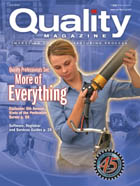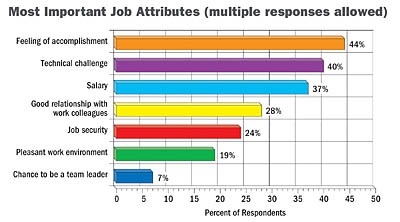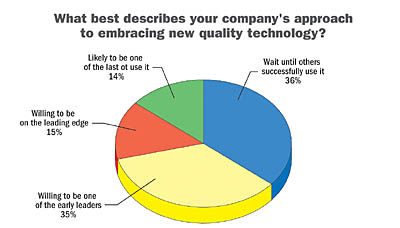
The quality of professional life for quality professionals remains on the rise, according to Quality Magazine's Sixth Annual State of the Profession Study. This exclusive survey peeks inside the careers of quality professionals to highlight their opinions, wallets and demographics. It reveals growing feelings of accomplishment and the enjoyment of tackling the technical challenges they face. This year, the mixed news is that while quality professionals are getting paid more and have a higher degree of satisfaction, they are being asked to do more too. How does your professional mindset and career contentment rank against this year's feedback?

Getting Paid
Survey respondents say their average salary is $71,000, up 4.41% from the $68,000 reported last year. This $71,000 figure is the highest for average salaries in the past six years the survey has been conducted: 2004, $66,570; 2003, $65,190; 2002, $64,180; 2001, $66,160. Twenty-five percent of this year's respondents claim to have an average salary of more than $85,000 per year.



Of the various job functions, corporate management-as could be expected-has the highest average annual salary of $116,000. This number is up less than 1% over last year's average of $115,000. The second highest average annual salary of $84,970 goes to professionals working in manufacturing and management operations. This number is up 7.8% over last year's average of $78,850. There is a tie for third place for average annual salaries between manufacturing engineering quality professionals and research, and development professionals. Both groups earn approximately $73,000 per year.

Looking forward, 72% of respondents expect to receive a salary increase at their next performance review. This is a 3% increase compared to the 69% of respondents last year who anticipated salary increases. This year, only 27% of respondents anticipate no annual salary change and 1% anticipate a salary decrease.
Factors that respondents say weigh heavily in compensation increase or decrease include overall company performance, overall operating performance, maintaining standards and meeting deadlines for new projects.

Hours and Satisfaction
Who comprises the quality workforce?- As would be expected, 75% of respondents reported their primary job function is quality/product
assurance/control.
- Supervisory responsibility was cited by 63% of all respondents and the average number of people supervised was 10.
- The average respondent is 48-years-old.
- Men represent 89% of survey
respondents.
- The average number of employees at each company cited by respondents was 10,579 employees and the average length of employment at respondents' current company is 12 years.
Sixty percent of respondents cite no change in the number of hours spent at work during the past year. Thirty-four percent cite their hours have increased and 6% cite a decrease. The average workweek is 48 hours, a level that has been the same for the past four years. Only 27% of respondents work 51 or more hours per week. For the 34% of respondents citing more hours, the additional average time spent at work was six hours per week.
Quality professionals have been feeling the sting of rising health care costs. Seventy-nine percent of respondents say they expect the amount they pay for health insurance at work to increase during the next 12 months. Only 14% say they do not expect rates to increase and 7% say they do not use company-issued health insurance.


These satisfaction statistics are higher than those reported in a recent unrelated study on office stress conducted by careerbuilder.com that included 2,500 on-line responses. More than three-fourths of respondents in this unrelated survey say they feel job burnout, while more than 50% feel they are under a "great deal of stress." In this unrelated survey, sixteen percent of respondents blame their colleagues for their office woes, followed by unrealistic workload, tight deadlines, last-minute projects and meddling bosses. "High-pressure work environments are taking their toll on workers' moral," says Rosemary Haefner, careerbuilder.com's vice president of human resources. "This can be detrimental to both workers, whose health and career progress may suffer, and employers, who pick up the tab in higher insurance costs and lost productivity."


Methodology
A total of 23,537 active, qualified Quality Magazine direct request subscribers were selected from the domestic-United States only-circulation with e-mail addresses whose job titles were management, manufacturing engineering, manufacturing/operations, quality/product assurance, engineering/technical and research & development. These subscribers' principle product manufactured includes: furniture and fixtures, rubber and miscellaneous plastic products, primary metal industries, fabricated metal products, nonelectronic machinery, electric and electronic equipment, transportation equipment and instruments and related products.A Web-based survey instrument was designed for the study by the Market Research staff of BNP Media. It was sent via e-mail to subscribers. As an incentive for response, one out of every 100 respondents had a chance to win a $50 American Express gift certificate. The survey was returned by 1,211 people for a response rate of 7%.
Quick tips on the average quality professional:
- Women working in the quality arena are still being paid less than their male counterparts. For the 126 women who responded, the average salary was $56,000.- Women are not only making less than men, women's average salary amount for the year is 5.3% lower than last year's average of $59,140.
- Overall, 36% of respondents claim to be highly satisfied at work, while 55% say they are moderately satisfied.